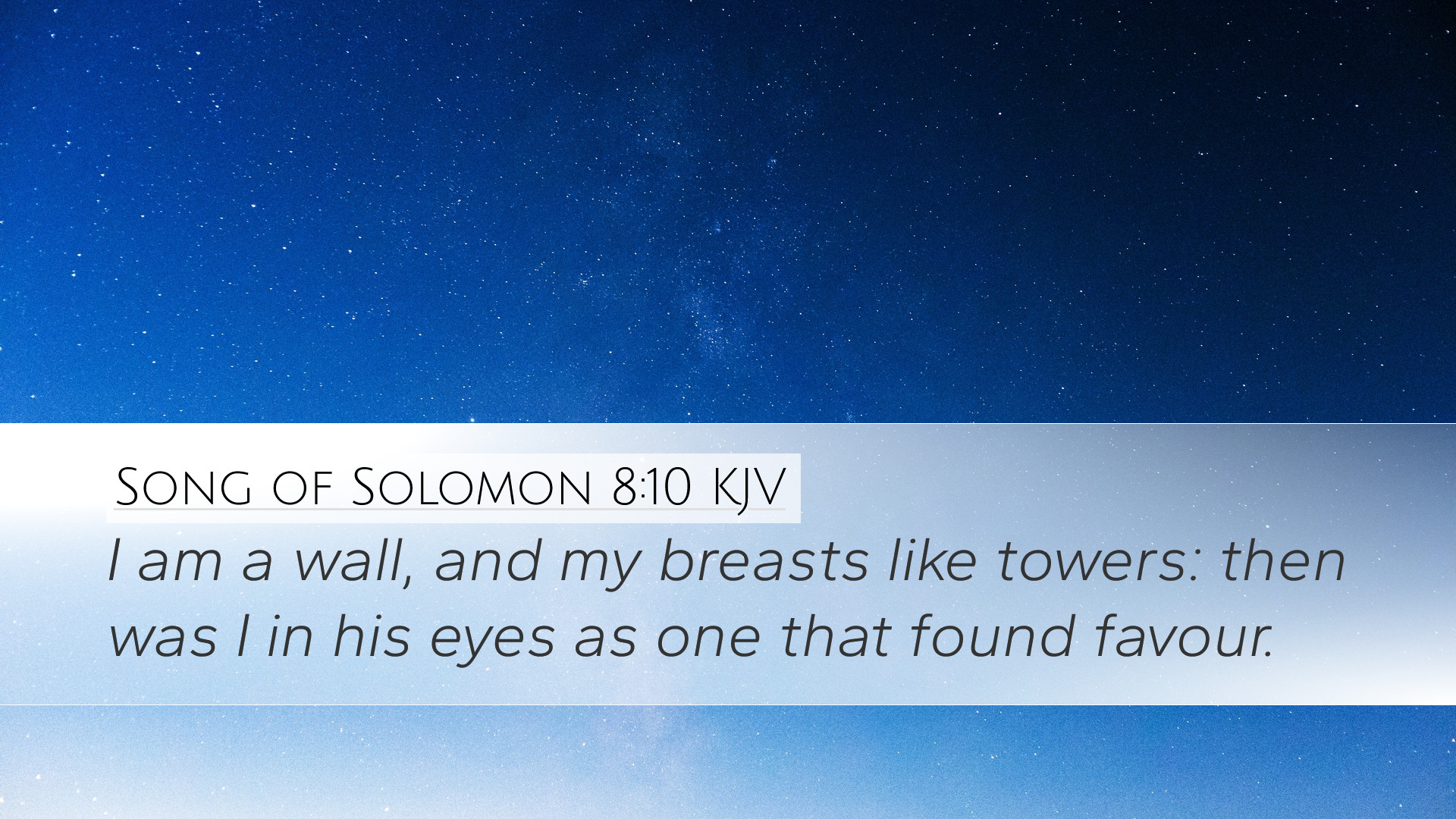Old Testament
Genesis Exodus Leviticus Numbers Deuteronomy Joshua Judges Ruth 1 Samuel 2 Samuel 1 Kings 2 Kings 1 Chronicles 2 Chronicles Ezra Nehemiah Esther Job Psalms Proverbs Ecclesiastes Song of Solomon Isaiah Jeremiah Lamentations Ezekiel Daniel Hosea Joel Amos Obadiah Jonah Micah Nahum Habakkuk Zephaniah Haggai Zechariah MalachiSong of Solomon 8:10
Song of Solomon 8:10 KJV
I am a wall, and my breasts like towers: then was I in his eyes as one that found favour.
Song of Solomon 8:10 Bible Commentary
Commentary on Song of Solomon 8:10
Bible Verse: Song of Solomon 8:10
"I am a wall, and my breasts like towers: then was I in his eyes as one that found favour."
Introduction
The verses of the Song of Solomon are richly layered with meaning, presenting vivid imagery and profound romance. Here in chapter 8, verse 10, the beloved woman speaks of herself in a manner that encapsulates the themes of love, strength, and favor. Drawing from the insights of esteemed commentaries, we will explore the significance of this verse in the context of love, metaphorical representation, and its implications for a deeper understanding of human relationships as envisioned in the biblical narrative.
Metaphorical Significance
The reference to being "a wall" is a powerful metaphor that denotes strength, protection, and steadfastness. As noted by Matthew Henry, this imagery suggests that the woman views herself as a wall, providing security and maintaining integrity in her relationship. She stands firm and unyielding against the trials that come against love, a portrayal that serves to elevate her status in the eyes of her beloved.
Albert Barnes expounds on this metaphor further, indicating that walls serve as boundaries that protect what is within. In the context of love, she declares her commitment and the exclusive nature of her affection. By portraying herself as a wall, she asserts her identity and establishes the sanctity of the love she shares, which is both intimate and fortified against external pressures.
Adam Clarke offers an additional layer of meaning by associating the breasts likened to towers with strength and nurturing. Just as towers stand tall and visible, representing watchfulness and guardianship, so too does her femininity signify a nurturing spirit combined with strength. This image reflects a balance where vulnerability is embraced but stands as a component of her overall strength.
The Concept of Favor
In the latter part of the verse, the phrase “then was I in his eyes as one that found favour” highlights the deep emotional connection and esteem that the woman feels between herself and her beloved. Matthew Henry points out that the perception of favor from her beloved enhances her value and worth. This reflects a mutual recognition and admiration within the relationship, portraying love as a fruitful dynamic of respect and appreciation.
Albert Barnes supports this notion by emphasizing that favor is often rooted in intimacy and loyalty. The woman's statement embodies not only her self-esteem but also reflects how love transforms perceptions, making her feel cherished and favored. This speaks to the transformative power of love, where partners uplift each other through their respective devotion.
Adam Clarke reinforces this idea by suggesting that favor is indicative of a relationship built on genuine affection. In biblical theology, favor often denotes an act of grace and kindness, thus the inclusion of this phrase underlines how such grace exists within the boundaries of mutual love.
Relational Dynamics
The dialogue in this verse points to the relational dynamics that often define romantic engagement. It suggests a reciprocal understanding where both parties contribute to the foundation of their love. Matthew Henry notes that the mutual respect and “favor” serve to solidify bonds, where the wife’s strength complements the husband’s love.
Albert Barnes further elaborates on this relational dimension by indicating that the wife's declaration is not merely self-praising but a reaction to her beloved's perception. The reciprocal acknowledgment enlarges the relationship's depth, wherein each partner recognizes the attributes of the other. This creates a space for vulnerability and robustness, essential characteristics of a meaningful romantic bond.
Finally, Adam Clarke contributes by observing that the woman’s emphasis on being a wall signifies her stability, which invites her partner to see her as an essential pillar within their relationship. This metaphor exemplifies the strength that love should embody, where each partner acts as a supporter to the other, establishing a loving sanctuary that withstands external pressures.
Application for Pastors, Students, and Theologians
This verse serves as a profound illustration of how love operates within the dynamics of relationships. For pastors, it can be a reminder of the spiritual significance of marital relationships, emphasizing the need for strong foundations built on mutual appreciation and respect much like Christ’s love for the church.
For students and theologians, it invites a deeper exploration into the metaphors employed in Scripture, urging them to unravel the layers of meaning that contribute to understanding biblical love narratives. The insights from the commentaries encourage reflective study not only of the text but of the divine principles guiding relationships.
Moreover, it asserts the importance of recognizing one's self-worth within the context of love. As the woman perceives herself through the lens of strength and favor, so should individuals understand their inherent value formed in the image of the divine, which further enriches their relationships.
Conclusion
Song of Solomon 8:10 encapsulates aspects of love that are vital for nurturing successful and fulfilling relationships. The imagery surrounding the wall and towers combined with the sense of favor highlights the interplay of strength and tenderness inherent in romantic love. As we delve into such scriptures, it becomes clear that they serve as both an encouragement and a blueprint, guiding not only the romantic involvement but the broader understanding of love as a God-ordained covenant.


